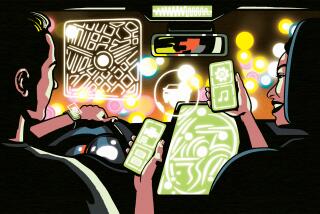In-Car Net Access: Spotty and Pricey
- Share via
LAS VEGAS — At the Consumer Electronics Show -- the annual bacchanal of gadgetry in Las Vegas -- sometimes the technology is more intoxicating than useful.
A case in point: Satellite-based Internet service for cars.
Rolling down the famed Strip in a Ford Explorer last week, I tried out a system developed by RaySat Inc. that sent my mouse clicks and keystrokes directly to a satellite 22,000 miles above the Earth and returned Web pages, e-mail, music and instant messages back down to my laptop. (Don’t worry, I wasn’t driving.)
The SUV essentially became a roving satellite-transmission platform. Unlike the passive reception of satellite TV and radio, this technology promises to allow consumers to interact directly with a satellite by sending signals into space.
The Consumer Electronics Show was the coming-out party for RaySat’s SpeedRay 3000 Internet system, which the Vienna, Va., company has been developing for a couple of years. It uses global positioning system technology to aim its car-top antenna, which looks a bit like an oversize cafeteria tray, at a satellite in geosynchronous orbit. The Internet signal comes down from the satellite and fills the car via a wireless modem hooked up to the antenna.
It took a couple of minutes of fiddling to get my laptop signed on, but once it took hold the results were impressive. I was able to surf the Net as if I was in any wireless hotspot. I played a couple of tunes from Rhapsody’s music service, checked my e-mail and watched a streaming-video news clip. I exchanged instant messages with a colleague back at the office, telling him what hotels I was passing.
Then, somewhere around the Mirage, the fun ended.
My Web access became spotty, the music quit and my colleague went silent. It was as if I had suddenly gone undercover, but in truth my signal was being blocked by the hotels. This technology relies on line-of-sight access to the satellite, and if a building or a tree gets in the way, the signal dies, at least momentarily.
My connection was on and off as we traveled down the Strip. Would I get back online by the time I reached Paris (Las Vegas)? Yes, but only for a moment. I had to send my instant messages quickly and type URLs at top speed to get Web pages before being cut off.
Giving up on the Strip, we headed out to the open desert spaces just south of the city. Here, the system thrived.
The RaySat package, which the company plans to get into the marketplace midyear, will retail for $6,995.
The included hardware consists of the 48-by-37-inch rooftop antenna and three separate boxes -- each about the size of a laptop -- that contain the antenna controller, antenna modem and TV set-top box. Installation is extra; RaySat estimated a cost of about $500.
There will also be a monthly charge for Internet access of $50 or $100, depending on which package you choose. The $50 option gives you 10 hours a month of peak use, then it’s $5 an hour. Off-peak usage is $2.50 an hour after the first 10 hours. The $100 option is similar, except that the free off-peak hours are unlimited.
Clearly, this setup could get very expensive in a hurry. And the bulkiness of the gear makes it suitable only for large vehicles such as vans, big trucks, SUVs and RVs.
“Obviously, we are going after the high-end market,” said Jim Robnett, head of sales for RaySat. “The RV owners that have major vehicles. And on the commercial side, truckers who want Internet.
“Our surveys show there is a lot of interest among people who spend a lot of time on the road.”
Fortunately, there are less expensive ways for the rest of us to get rolling Wi-Fi.
One is a wireless car system debuted in Las Vegas by KVH Industries Inc. and Microsoft Corp. It gets its Internet signal through a high-speed, cellular technology called Evolution-Data Optimized (EV-DO), which is not burdened with line-of-sight issues.
KVH designed the hardware for the system, which can be used with a laptop or other Wi-Fi-enabled device. Microsoft brings to the package its MSN TV service (successor to its failed Web TV venture). But that can be accessed only from a wireless keyboard that comes with the package and TV screens in your vehicle, which are not included.
The system, which the company said would cost less than $1,000, is also due to come out midyear. Besides the keyboard, the included hardware consists of a box -- about the size of a cable TV box -- that contains the EV-DO receiver and a wireless router and can be installed under most car seats. Installation is not included; the company said that probably would set you back $100 or so.
The package will come with initial subscriptions for the EV-DO service and MSN TV. KVH declined to say for how long the subscriptions would be free or to specify the eventual monthly charge, saying only that the cost would be less than $100.
The advantage of EV-DO is that it can be used just about anywhere the technology is available. But in many parts of the country, that’s limited to major cities. For example, it’s great in Las Vegas, but drive outside the city and the system reverts to a far slower cellular technology. EV-DO coverage is particularly widespread in Southern California -- it’s available in most parts of Los Angeles, Orange and Ventura counties.
An even cheaper way to get mobile Internet access is via PC cards that can pick up EV-DO signals and those of a competing cellular data service known as Edge. Those cards can be had for about $150, plus monthly cellular fees. They don’t provide service to a whole vehicle, but can supply Wi-Fi to a single laptop anywhere these cell data services are available.
All of this raises an obvious question: Who really needs Wi-Fi in the car?
For one thing, it’s no use to the driver unless you pull over and park.
Even for passengers, typing in a moving vehicle is not much fun. I tried to do some writing on the way to Las Vegas while a colleague drove, and I was soon feeling queasy -- although some of the blame could be assigned to my 1997 Honda Civic, which is hardly a smooth ride.
Maybe kids would enjoy Web access in the car, but they already have lots of mobile entertainment options, including portable DVD and music players and game devices.
Given the lack of an obvious need for it, and the cost and limitations of the technology, I don’t see a big future for rolling in-car Internet access, at least not soon.
But don’t make any investments on my advice -- I once was sure that no one would want to buy ring tones.
*
David Colker can be reached via e-mail at technopolis@latimes.com. Previous columns can be found at latimes.com/technopolis.







